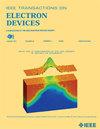Cavity Design for a High-Power, Frequency-Agile 198 GHz Gyrotron
IF 2.9
2区 工程技术
Q2 ENGINEERING, ELECTRICAL & ELECTRONIC
引用次数: 0
Abstract
Gyrotrons are high-power microwave sources, readily applied in diverse fields ranging from fusion research and thermal treatment of materials to advanced spectroscopic techniques. Here, we provide the cavity design of a 198 GHz gyrotron to generate microwaves with kW level power and a frequency bandwidth of several hundreds of MHz. The design focuses on the interaction cavity, while all other components of the vacuum tube remain unchanged from a currently operational 198 GHz, 60 W frequency-agile gyrotron. The proposed cavity geometry allows for two operating points, one optimized for frequency agility, and the other for high power. Cavity interaction code simulations show that frequency tunability over a range of 400 MHz can be reached using a smooth transition between the first and second axial mode excitations. In addition, these simulations indicate that up to 7 kW microwave power can be obtained at the high-power operating point. Furthermore, the ohmic load deposited on the walls of the interaction cavity was investigated for high-power operation. The expected microwave power and frequency agility of the cavity are promising for applications such as dynamic nuclear polarization (DNP) spectroscopy and electron paramagnetic resonance (EPR) experiments.大功率、频率捷变198ghz回旋管腔体设计
回旋管是一种大功率微波源,广泛应用于从聚变研究、材料热处理到先进的光谱技术等各个领域。在此,我们提供了198ghz回旋管的腔体设计,以产生功率为kW级,频率带宽为数百MHz的微波。设计的重点是相互作用腔,而真空管的所有其他组件与目前运行的198 GHz, 60 W频率敏捷回旋管保持不变。所提出的腔体几何形状允许两个工作点,一个优化频率敏捷性,另一个用于高功率。空腔相互作用代码模拟表明,通过在第一和第二轴向模式激励之间的平滑过渡,可以达到400 MHz范围内的频率可调性。此外,仿真结果表明,在大功率工作点可获得高达7kw的微波功率。此外,还研究了高功率工作时作用腔壁上的欧姆负载。预期的微波功率和频率敏捷性为动态核极化(DNP)光谱和电子顺磁共振(EPR)实验等应用提供了前景。
本文章由计算机程序翻译,如有差异,请以英文原文为准。
求助全文
约1分钟内获得全文
求助全文
来源期刊

IEEE Transactions on Electron Devices
工程技术-工程:电子与电气
CiteScore
5.80
自引率
16.10%
发文量
937
审稿时长
3.8 months
期刊介绍:
IEEE Transactions on Electron Devices publishes original and significant contributions relating to the theory, modeling, design, performance and reliability of electron and ion integrated circuit devices and interconnects, involving insulators, metals, organic materials, micro-plasmas, semiconductors, quantum-effect structures, vacuum devices, and emerging materials with applications in bioelectronics, biomedical electronics, computation, communications, displays, microelectromechanics, imaging, micro-actuators, nanoelectronics, optoelectronics, photovoltaics, power ICs and micro-sensors. Tutorial and review papers on these subjects are also published and occasional special issues appear to present a collection of papers which treat particular areas in more depth and breadth.
 求助内容:
求助内容: 应助结果提醒方式:
应助结果提醒方式:


